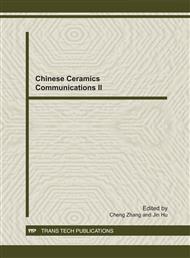p.271
p.275
p.280
p.285
p.290
p.294
p.298
p.302
p.306
Effect of Low-Temperature Frit on the Sintering Behavior and Properties of 0.95K0.49Na0.51NbO3-0.05LiSbO3 Lead-Free Piezoceramics
Abstract:
The effects of low-temperature frit Li2O-Na2O-K2O-B2O3-SiO2-CaO-BaO-ZnO (abbreviated as BS) on the sintering behavior and electrical properties of 0.95K0.49Na0.51NbO3- 0.05LiSbO3 (abbreviated as KNN-LS) lead-free piezoceramics were investigated. The sintering temperature of the KNN-LS ceramics can be reduced from 1080 °C to 1000 °C due to the addition of BS frit. For the 0.5 wt% BS-doped KNN-LS ceramics, which are sintered at reduced temperature of 1000 °C for 2 h, remain relatively high piezoelectric constant d33 (195 pC/N) and planar electromechanical coupling coefficient kp (40.7%). In addition to other optimization effects, such as reduction of dielectric loss from 3.6% to 2.7% and increment of mechanical quality factor Qm from 48 to 70, this BS frit was experimentally proved to be good for low temperature sintering of KNN-based ceramics while maintaining high piezoelectric response.
Info:
Periodical:
Pages:
290-293
Citation:
Online since:
November 2011
Authors:
Keywords:
Price:
Сopyright:
© 2012 Trans Tech Publications Ltd. All Rights Reserved
Share:
Citation:


